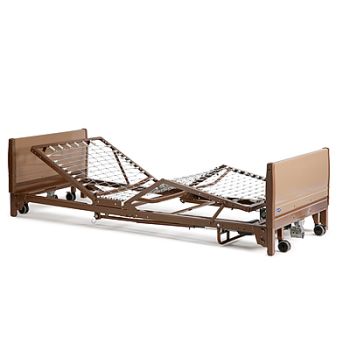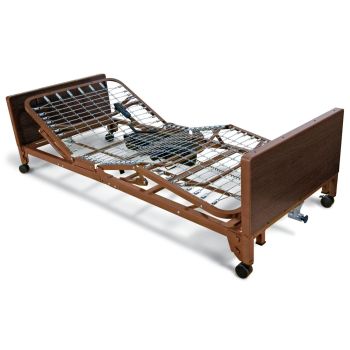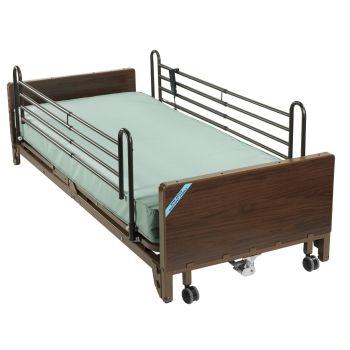Free shipping orders over $50
High Low Hospital Bed / Full Electric Hi-Lo Hospital Bed

High low hospital beds, also known as hi-low beds for the home, are completely adjustable and have an enhanced head, foot, and height adjustability when compared to standard traditional beds. Here at AvaCare Medical, we have some of the best high low electric beds available to suit your needs, as well as extensive knowledge about them. Read more...
-
Invacare Full Electric Low Hospital Bed
Starting at $1,292.30 -
Medline Full Electric Low Basic Bed
Starting at $692.17 -
Delta Ultralight Full-Electric Low Bed
Starting at $1,015.42
Who Can Benefit from a High Low Hospital Bed?
Many people can benefit from these hospital beds. Since they are completely adjustable, they help the user to position themselves as needed.They also improve circulation, ensure easier transferring (for both the patient and caregiver), and so much more. High low beds are designed to help the patient the same wat a standard hospital bed will and can alleviate numerous ailments and conditions. Some people who can benefit from the use of a hi low hospital bed are:
- Users with heart conditions, such as heart failure, heart disease, angina, etc.
- Users with debilitating musculoskeletal diseases such as muscular dystrophy, paralysis, past polio, or multiple sclerosis.
- Those with workman’s compensation injuries, amputations, congenital birth defects, automobile accident injuries, and even military injuries.
- Those who need postoperative care for hip, leg, knee, spinal, or other surgeries that require them to be confined to a bed for a length of time.
- Sufferers of chronic respiratory diseases, such as COPD (chronic obstructive pulmonary disease), cystic fibrosis, chronic bronchitis, etc.
- Sufferers of gastrointestinal problems – hiatal hernia, irritable bowel syndrome, diverticulitis, and colitis.
- People who need to stay bedridden due to any other reason.
Types of High Low Beds
There are many different types of hi low beds for the home available on the market, and each type offers its own set of advantages. There are certain things to consider when purchasing a hi low bed, because while they are adjustable, they may have different measurements and heights compared to standard hospital beds. The standard height of a hospital bed is appropriate to the average knee height of either males or females; 21.3 inches and 19.5 inches respectively. They therefore generally offer an average range of 15”-23” to accommodate individual height preferences. Low beds, by contrast, usually provide a height range of 9.5”-20”, which accommodates most prefered heights. The following high low beds offer this wide range, as well as even more extensive capability!
| Bed Name | Minimum Height | Maximum Height |
|---|---|---|
|
Carroll CS7 Bed w/ Swivel Wheels |
7" |
30" |
|
Carroll CS9 Bed w/ Swivel Wheels |
9" |
30" |
|
Carroll CS3 Bed w/ Swivel Back |
8" |
27" |
|
Carroll Deluxe Low Electric Bed |
9" |
21" |
|
Delta Ultralight Full-Electric Low Bed |
9.5" |
20.5" |
|
Invacare Full Electric Low Hospital Bed |
9.5" |
20" |
|
Medline Full Electric Low Basic Bed |
9.5" |
20" |
Fully Electric
A full-electric hi lo hospital bed is a very common choice. These beds feature select height adjustments of multiple levels and variances. They allow for easy head, foot, and base height adjustment. High low electric beds are classified as such simply because each section can raise or lower more than the standard heights mentioned above. This means that they can be used to help incline patients easily by the means of electronics, either with a remote control or with electronic controls on the beds themselves. High Low electric hospital beds present great options for those with some limited mobility or those who need to be transferred frequently when the caregiver does not have the time nor the physical capacity to continuously raise or lower the bed by physical means. Fully-electric beds still may have manual adjustment controls for the sake of emergencies, however.
Semi Electric | Half Electric | Hybrid Electric
Semi-electric hi-lo beds are very similar and offer the same advantages as a full-electric bed. The primary exception is that semi-electric beds have a hand crank to adjust the base height of the entire bed itself, although the head sections and foot sections are easily controlled by electronic means. A semi-electric bed does not have an electronic bed height adjustment on them, so they still also may have manual adjustments for the head and foot sections for emergencies similar to fully-electric models. They are designed more specifically for those who are prone to falling and who need the bed to be at a lower stationary position from time to time.
Manual Beds
Manual high low hospital beds are primarily used among patients who are basically or entirely bedridden. These beds can be adjusted completely manually. They are often the lower-priced option because of the lack of electronics and the basic functionalities of adjustment benefits that they provide both users and caregivers. A manual bed may not be the best choice for home care use if the caregiver is unable to adjust the bed frequently (or at all) due to physical fitness limitations.
Choosing the Right High Low Hospital Bed
When choosing a high low bed, one must understand that they first need to determine the bed type that they will require based on the information above. Along with this, they need to determine other factors which can turn out to be instrumental factors when choosing and using the bed. Some of these things which need serious consideration are as follows:
- The weight of the mattress, the user, and any attached accessories or items should never exceed the weight capacity of the bed frame. Always select the proper weight capacity before choosing the other items. When in doubt, choose a model that has a higher capacity than needed.
- Is the person prone to rolling out of bed? If the user has limited mobility but has some independence with transfers, can they get up and down on their own? If the answer to any of these questions is yes, then they may need to have bed rails installed which can be purchased separately. If one is still in the process of choosing a high low bed, one may choose one that already comes with this particular attachment.
- If the person is elderly or subject to accidental bodily harm, bumper guards - along with bed rails - may be purchased and used. These represent great supplements to other special accommodations to help protect them from injury.
- The size of the bed must be appropriate to allow for enough room for both adjustment and placement in the room in which it will be placed. Most beds are twin-sized mattress beds, while some bariatric models and extended beds (commonly used for taller people) can sometimes hold a full-size mattress.
Find a high low hospital bed that is perfect for your needs by shopping at AvaCare Medical today! If you should have any questions, our customer care staff is ready to answer the call – all you have to do is dial 1-877-813-7799. Additionally, you can send us an email anytime and we’ll respond promptly!
References:
Tzeng, H.-M., Prakash, A., Brehob, M., Devecsery, D. A., Anderson, A., & Yin, C.-Y. (2012, June). Keeping patient beds in a low position: an exploratory descriptive study to continuously monitor the height of patient beds in an adult acute surgical inpatient care setting.
Roubenoff R, Wilson PW. Advantage of knee height over height as an index of stature in expression of body composition in adults. The American Journal of Clinical Nutrition. 1993;57(5):609–613.





